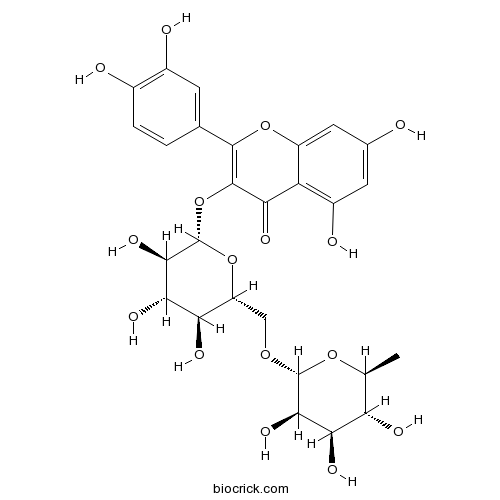A rutinoside that is quercetin with the hydroxy group at position C-3 substituted with glucose and rhamnose sugar groups.
InChI=1S/C27H30O16/c1-8-17(32)20(35)22(37)26(40-8)39-7-15-18(33)21(36)23(38)27(42-15)43-25-19(34)16-13(31)5-10(28)6-14(16)41-24(25)9-2-3-11(29)12(30)4-9/h2-6,8,15,17-18,20-23,26-33,35-38H,7H2,1H3/t8-,15+,17-,18+,20+,21-,22+,23+,26+,27-/m0/s1
Rutin is a natural antioxidant, all doses can diminish reactive oxygen species and high doses (10-100 microM) decrease malondialdehyde concentration; induce favorable changes in the antioxidant defense system of cultured HepG2 that prevent or delay conditions which favor cellular oxidative stress.[1]
Rutin, can dose-dependently inhibit Aβ42 fibrillization and attenuate Aβ42-induced cytotoxicity in SH-SY5Y neuroblastoma cells, and decrease the formation of reactive oxygen species (ROS), NO, glutathione disulfide (GSSG), and malondialdehyde (MDA), reduce inducible nitric oxide synthase (iNOS) activity, attenuate mitochondrial damage, increase the glutathione (GSH)/GSSG ratio, enhance the activities of super oxide dismutase (SOD), catalase (CAT) and glutathione peroxidase (GPx), and modulate the production of proinflammatory cytokines by decreasing TNF-α and IL-1β generation in microglia.[2]
Rutin(200 mg/kg) has gastroprotective effect through an anti-lipoperoxidant effect, and also by enhancement of the anti-oxidant enzymatic (GSH-Px) activity.[3]
Rutin (R) in combination with vitamin E (VE) synergistically inhibit oxidative damage, attenuates expression in -60 cells and that this effect is mediated by a decreased activity of through down-regulation of protein expression of (-R)/, while the of R+VE appears to play a minor role.[4]
Rutin attenuates ischemic neural apoptosis by reducing the expression of p53, preventing morphological changes and increasing endogenous antioxidant enzymatic activities, thus, rutin treatment may represent a novel approach in lowering the risk or improving the function of ischemia–reperfusion brain injury-related disorders.[5]
[1] Alía M, Mateos R, Ramos S, et al. Eur J Nutr , 2006, 45(1):19-28.
[2] Wang S W, Wang Y J, Su Y J, et al. Neurotoxicology, 2012, 33(3):482-90.
[3] Kreft I, Fabjan N, Yasumoto K. Food Chem, 2006, 98(3):508-512.
[4] Mondul A M, Rager H C, Kopp W, et al. J Nutr, 2011, 141(11):2030-4.
[5] Khan M M, Ahmad A, Ishrat T, et al. Brain Res, 2009, 9(1292):123-35.
[6] Athar M T. J Liq Chromatogr R T, 2011, 34(6):446-455.



